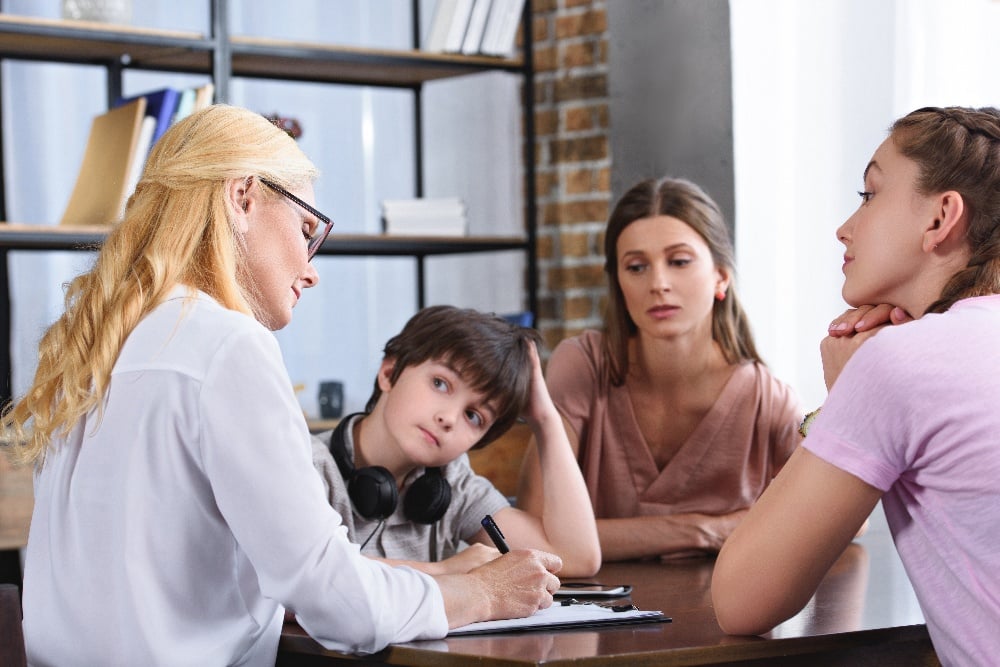Teen Anxiety
A knot in the pit of the stomach that arrives before giving a speech in class or the sweaty palms when a class crush passes a note are normal reactions to stress and anxiety for teens. However, when the stomachaches become persistent and participating in social activities with friends and family becomes difficult, these may be red flags signaling a more serious issue with anxiety.

Table Of Content
- Teen Anxiety: Long-Term Risks
- Why the Increase in Teen Anxiety?
- Symptoms of Anxiety in Teens
- Role of Childhood Trauma
- What Is an ACE?
- How Does Trauma Manifest?
- How Trauma Can Manifest as PTSD
- Does All Trauma Lead to Anxiety and PTSD?
- Common Subtypes of Teen Anxiety
- Treatment Options
- What Can Parents Do?
Teen Anxiety: Long-Term Risks
A certain amount of anxiety is good for us, even as teens. It acts as an alarm system warning us of danger to keep us safe. However, when stress and anxiety come in larger-than-normal doses, it can be crippling, making our ability to function in life a daily struggle. Unfortunately, anxiety is one of the most common mental health issues our teens face today.
According to the Centers for Disease Control (CDC), 7.1% of kids ages 3–17 have been diagnosed with an anxiety disorder. That's over 4.4 million people under the age of 18 known to suffer from anxiety. Teen anxiety has been consistently on the rise each year over the last few decades, increasing 20% between 2007 and 2012 alone.
One in three teens will be diagnosed with an anxiety disorder by the time they reach age 18, according to the National Institute of Mental Health (NIMH). According to a Children's Mental Health Report, 80% of kids with diagnosable anxiety are not getting the treatment they need.
Untreated anxiety in childhood can lead to more serious mental health issues later on in adulthood. If not treated, kids who suffer from anxiety may seek out pain-relieving coping methods to help numb their symptoms, including turning to drugs and alcohol for relief. Other coping mechanisms include changes in eating habits, self-isolation, self-harm, engaging in risky behaviors, addictions to technology, social media, music, exercise, shopping, and more.
It's also quite common for teens who suffer from anxiety to experience depression or behavioral problems. One in three teens diagnosed with anxiety is also diagnosed with depression. In comparison, another one out of three teens diagnosed with anxiety struggles with a behavioral problem. Early intervention and treatment are of the utmost importance.
One in three teens will be diagnosed with an anxiety disorder by the time they reach age 18.
80% of kids with diagnosable anxiety are not getting the treatment they need.
Why the Increase in Teen Anxiety?
As kids and teens, we go through ups and downs, friendships and fights, first loves, breakups, and other phases of growing pains and conflict in relationships. Growing up can be challenging and even more demanding when there's added stress in the home or conflict at school.
We also live in a society where there are threats to our overall sense of safety, all of which can contribute to anxiety. Our schools no longer feel safe; we see tragic events on the news, and children must engage in drills to prepare for shooters and natural disasters alike.
We've also witnessed a variety of terrorist attacks in recent years, and the ever-present threats to our planet due to climate change are more noticeable. It's easy to feel stressed or anxious daily simply from thinking about the world's problems.
With all of the stresses we experience—within our society, our schools, our homes, and our personal lives—how our teens manage stress and anxiety can have a significant impact on their overall mental health.
Symptoms of Anxiety in Teens
To effectively help your teen manage anxiety, it's essential to know the symptoms. Some common symptoms to look out for that could indicate teen anxiety include:
- Feeling tired or exhausted
- Feeling restless
- Being tense or on high alert
- Emotional outbursts
- Excessive worry that's inflated beyond the everyday stress of a situation or without cause
- Moodiness, irritability
- Aches and pains
- GI issues, stomachaches, headaches
- Avoidance of specific people or situations that can trigger anxiety
- An inability to focus or concentrate
- Self-isolation or social withdrawal
- Changes in eating habits
- Changes in sleeping patterns
Role of Childhood Trauma
While the effects of anxiety can be detrimental to anyone's sense of safety, the root causes are often far more upsetting. Children who experience trauma—for example, any of the adverse childhood experiences (ACEs)—are at a greater risk for developing an anxiety disorder later on in life.
The most common form of anxiety that originates from a traumatic experience is post-traumatic stress disorder (PTSD). Anything seen as traumatic during childhood can lead to anxiety or PTSD later on in life, even into adulthood.
What Is an ACE?
Adverse childhood experiences (ACEs) are traumatic experiences that include abuse (emotional, physical, or sexual), physical or emotional neglect, abandonment, and dysfunction in the home. Trauma can also occur from being involved in a car accident or witnessing something tragic, such as death.
Trauma can result from any experience that leaves a child feeling as if their safety and well-being are in danger, such as witnessing parental abuse, using drugs, being incarcerated, or struggling with mental health. Sometimes trauma can even result from experiences that are not considered abuse but cause a traumatic reaction regardless, such as being hit with a belt or a paddle as discipline, living in poverty, or witnessing the divorce of two parents.
Trauma can also occur when we're infants, and according to some research, even while we're in the womb. Treating the symptoms of teen anxiety is a priority in supporting a child or teen's healthy development, especially if it's difficult to determine the root cause of the distress.
Untreated, the ACEs can often lead to toxic stress, which is the result of the body's stress responses consistently being activated. Toxic stress can wear us down and subtract years from our lives.
How Does Trauma Manifest?
Trauma can manifest in several ways as we age, depending on how each unique individual processes it.
For some, it's internalized. A child might disconnect from the emotional aspects of the experience, store stress in the body, and try to overcompensate for any personal shortcomings. Internalizing trauma and storing stress in the body can cause a person to become ill, gain weight, and become more susceptible to physical diseases. For others, trauma is externalized. A child might act out and engage in mimicking behaviors—expressing the trauma outwardly through play or social interactions with peers and engaging in risky behaviors.
When trauma becomes a pattern in a child's life, the consequences amplify. They may anticipate future trauma and go through life on "high alert," causing them to live in a state of survival mode. Even if there is no longer any trauma present in the life of a teen or adult, the anxiety can persist for years and impact both everyday life and how stressful or emotional situations are dealt with in the future.
Think of it this way: Even if a child, teen, or adult has escaped their trauma and established a calm work or home environment, that calm and safety may feel foreign after spending an extended period in survival mode. If they have an anxiety disorder, this can cause them to create conflict and an environment that requires a constant state of stress and anxiety, which is the only way they feel "normal." In this way, trauma and toxic stress can create a vicious cycle.
Living in survival mode can make personal development a struggle. An attitude of learned helplessness can develop out of childhood trauma, which causes teens and adults to project the helplessness they felt during traumatic experiences when they were younger onto current stressful situations and even everyday life.
How Trauma Can Manifest as PTSD
Traumatic events can become stuck in the brain's hippocampus, which is the part of the brain that timestamps our memories and stores them. When we experience trauma, the hippocampus can become paralyzed, preventing the traumatic event from being timestamped and stored with the rest of our memories. Instead, the traumatic event can rise to the surface at inopportune times and re-play as if we're living it again or watching it on a movie screen, referred to as a "flashback." Living in fear of having a flashback can only add to a person's anxiety and stress. It can even cause a person to fear going out in public.
Trauma can also block a person's memory, which is the case for some ACEs. While the root cause can remain unknown, the effects can manifest years later as anxiety and toxic stress. By releasing such memories through intervention and therapy, healing can begin.
Early intervention and treatment are essential for children and teens who suffer from anxiety, especially if there's any suspected trauma. The longer a kid waits to receive help and treatment, the greater their risk of developing more severe mental health disorders further down the line.
Does All Trauma Lead to Anxiety and PTSD?
Not every case of trauma will lead to an anxiety disorder or PTSD. It depends on a person's genetic makeup and unique brain chemistry. It also depends on emotional intelligence, coping skills, and how much resiliency and support a person has, providing another reason why early intervention is so crucial for children and teens who have experienced traumatic events, significant amounts of stress, or high-conflict environments.
Common Subtypes of Teen Anxiety
There are a variety of subtypes of anxiety disorders that vary based on the nature of the symptoms and treatment methods used. According to a 2010 article in the Journal of the American Academy of Child and Adolescent Psychiatry, 31% of U.S. teens will be diagnosed with one of the six following anxiety subtypes by age 185:
- A specific phobia (19%)
- Social anxiety (9%)
- Separation anxiety (6%)
- PTSD (5%)
- Panic disorder (3%)
- Generalized anxiety disorder (2%)
Treatment Options
Therapy is the first line of defense in treating the symptoms of stress, anxiety, and trauma. There may also be times when a selective serotonin reuptake inhibitor (SSRI) medication, a commonly prescribed antidepressant, will be prescribed to treat pervasive symptoms of teen anxiety.
Some common forms of therapy used to treat teen anxiety that are offered here at Idaho Youth Ranch include:
- Cognitive Behavioral Therapy (CBT)
- Eye Movement Desensitization and Reprocessing (EMDR)
- Trauma-Focused CBT (TF-CBT)
- Dialectical Behavioral Therapy (DBT)
- Equine-Assisted Psychotherapy (EAP)
Cognitive Behavioral Therapy (CBT)
CBT is the most widely used form of therapy for treating all types of anxiety disorders. This treatment focuses on challenging negative core beliefs and thought patterns while slowly facing fears and forming healthy coping skills.
Eye Movement Desensitization and Reprocessing (EMDR)
EMDR involves eye movement desensitization. The therapist creates a safe environment for the client, who is then able to go back and relive the traumatic experience while undergoing eye movement therapy to activate the hippocampus and timestamp the traumatic memory to be stored and, in turn, less powerful.
Trauma-Focused CBT (TF-CBT)
TF-CBT is a form of CBT that's ideal for working with families and also has a trauma-centered focus. This form of therapy brings families together and helps them cope with any traumatic event as a unit, resulting in the restoration of family bonds and the building of trust, communication, and coping skills.
Dialectical Behavioral Therapy (DBT)
DBT is a form of therapy rooted in CBT but designed to help clients achieve emotional regulation and balance, manage emotions and behavioral patterns, and effectively cope with the stresses that life can bring.
Equine-Assisted Psychotherapy (EAP)
Horses have been used to aid in therapy over the years, and the trend is growing. Working with horses includes improved self-esteem, setting healthy boundaries, and encouraging empathy, confidence, self-control, trust, honesty, social skills, self-discipline, self-respect, responsibility, accountability, and more.
What Can Parents Do?
It's essential to know that you are not alone and that teen anxiety is treatable.
Sometimes, as parents, siblings, and friends, we want to fix the problems we see our loved ones struggling with, and it can make us feel helpless when we're unable to offer a solution. The best thing you can do to help your loved one is to listen, show your support, and let them know it's okay to ask for and receive help whenever needed. Anxiety doesn't mean that a person is weak; instead, it's a testament to how strong they are to carry the extra burden of it every day.
Let your child or teen know that they are enough as they are and that they are valued and appreciated. It's important to stress the importance of support, as there's a natural tendency after experiencing trauma to want to avoid the topic altogether. However, facing the trauma allows them to move on and heal. With proper care, this can be a transformational experience that sets a child or teen on a better track for the future.
Related
Get the help and support you need

Teen Counseling
Our masters-educated and trained therapists and counselors have the experience your young person needs to find healing.

Family Counseling
Idaho Youth Ranch can help your family reconnect, open up lines of communication, and build more positive relationships.

Group Counseling
Group therapy helps young people, ages 9 to 24, to address trauma, dangerous behaviors, troubling feelings or experiences.

Equine Therapy
Working with horses has been a proven method of emotional recovery and one of the unique services offered by Idaho Youth Ranch.
